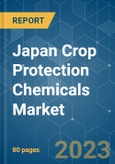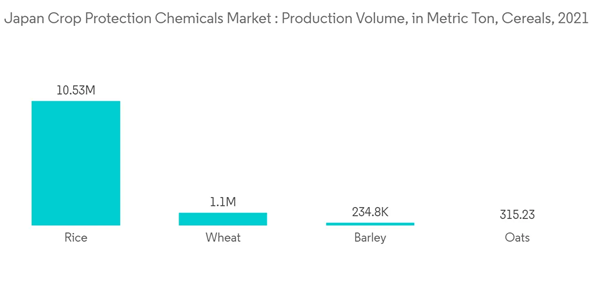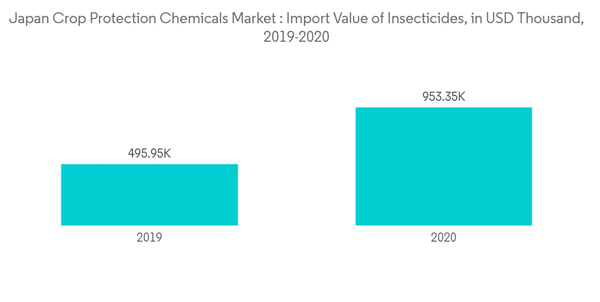Key Highlights
- The Japanese market for crop protection chemicals has continued to grow over the past few years and is majorly dominated by foreign players with their wide range of products. Insecticides, herbicides, and pesticides are the majorly used crop protection chemicals because of the high percentage of grains in the cultivated area and the considerable importance given to gardening in the region. According to the FAO, the agricultural usage of pesticides accounted for 51,970 metric tons in 2020.
- Crops like rice, soybean, wheat, barley, fruits, and vegetables are largely grown in Japan, accounting for the major usage of crop protection chemicals in the region. In spite of the small population and land area, Japan was a significant market for pesticides, occupying a prominent share in the Asia-Pacific region. The country has the highest pesticide usage per hectare of any other country in the world at approximately 12 kg /hectare.
- The expansion in the adoption of biopesticides and favorable government policies supporting the development of new innovative crop protection chemicals are some factors driving the market growth for Japanese crop protection chemicals. In March 2021, The Agriculture, Forestry, and Fisheries Ministry aimed to create a sustainable production system for farm products that do not rely solely on the use of chemical pesticides in the country. Japan’s farm ministry aimed a new strategy to promote eco-friendly approaches in the agriculture, forestry, and fisheries industries, including a goal of reducing the usage of chemical pesticides by half from the current level by 2050.
Japan Crop Protection Chemicals Market Trends
Increase in Grains and Cereals Production is Driving the Market
Japan is one of the largest producers of grain and cereals and is ranked the 12th largest producer of rice in the world. Grain and cereal products are of strategic importance in the whole world economy, also in Poland. They are essential ingredients of food; they are used in distilling, brewing, milling, and the industrial, energy, and pharmaceutical sectors.Cereals such as rice, wheat, corn, barley, millet, and oats are the major crops grown in the country. According to the Food and Agriculture Organization of the United Nations (FAO) statistics, the production of cereals increased from 11,685.5 thousand hectares in 2020 to 11,898.8 thousand hectares in 2021. This, in turn, explains their predominance in the total volume of plant protection chemicals in the country.
The most important active substance used on this crop includes pesticides Cyromazine and Fenitrothion. With extensive cultivation of grains and cereals carried out across various parts of the country, the pesticide market application on grains and cereals is projected to grow during the forecast period. The Government of Japan (GOJ) has proposed changes to the Maximum Residual Limits (MRLs) for Oxadiazon, Dimethenamid, Tebufenozide, Pyributicarb and Metaldehyde, as well as the maximum level for cadmium in rice.
Insecticides Dominate the Market
Insecticide is an agent that destroys one or more species of insects. The ease of application is a big advantage of chemical insecticides over mechanical pest control methods. This also helps save labor costs. Chemical companies are taking advantage of Japan’s weak laws on pesticide use by selling a wide variety of broad-spectrum pesticides for use in rice farming, including neonicotinoids banned in other countries. But other pesticide types with similarly devastating effects on aquatic ecosystems continue to be sold and promoted, such as Trebon, a synthetic pyrethroid sold by Mitsui Chemicals, and Prince, containing fipronil, a phenylpyrazole sold by BASF.According to information provided by the Japanese NGO Act Beyond Trust, five main companies, Bayer, BASF, and Syngenta from Europe and Sumitomo Chemical and Mitsui Chemicals from Japan, manufacture and sell rice-field insecticides in Japan. With efforts aimed at reducing unnecessary utilization of chemical insecticides and comparatively higher use of bio-insecticides, the Japanese insecticide market is expected to witness healthy growth during the forecast period, primarily due to increased demand for biological insecticides.
Additionally, Mitsui Chemicals promoted dinotefuran as a featured product in its Corporate Social Responsibility (CSR) report for the year to 31 March 2018, stating that agriculture was expanding due to growing demand amid a rising global population and economic development in emerging countries.
Japan Crop Protection Chemicals Industry Overview
The Japanese crop protection chemicals market is consolidated, with key players occupying the major market share. Some notable players operating in the market include Bayer, BASF SE, Syngenta AG, FMC Corporation, UPL Limited (Arysta LifeScience), and Sumitomo Chemical Co. Ltd. New product launches, partnerships, and acquisitions are the major strategies adopted by the leading companies in the market in the country. Along with innovations and expansions, investments in R&D and developing novel product portfolios are likely to be crucial strategies in the coming years.Additional Benefits:
- The market estimate (ME) sheet in Excel format
- 3 months of analyst support
This product will be delivered within 2 business days.
Table of Contents
Companies Mentioned (Partial List)
A selection of companies mentioned in this report includes, but is not limited to:
- Bayer CropScience AG
- FMC Corporation
- Syngenta CropProtection AG
- Kumiai Chemical Industry Co. Ltd
- Sumitomo Chemical Co. Ltd
- Nissan Chemical Corporation
- Mitsui Chemicals Agro Inc.
- BASF SE
- UPL Limited (Arysta LifeScience)










